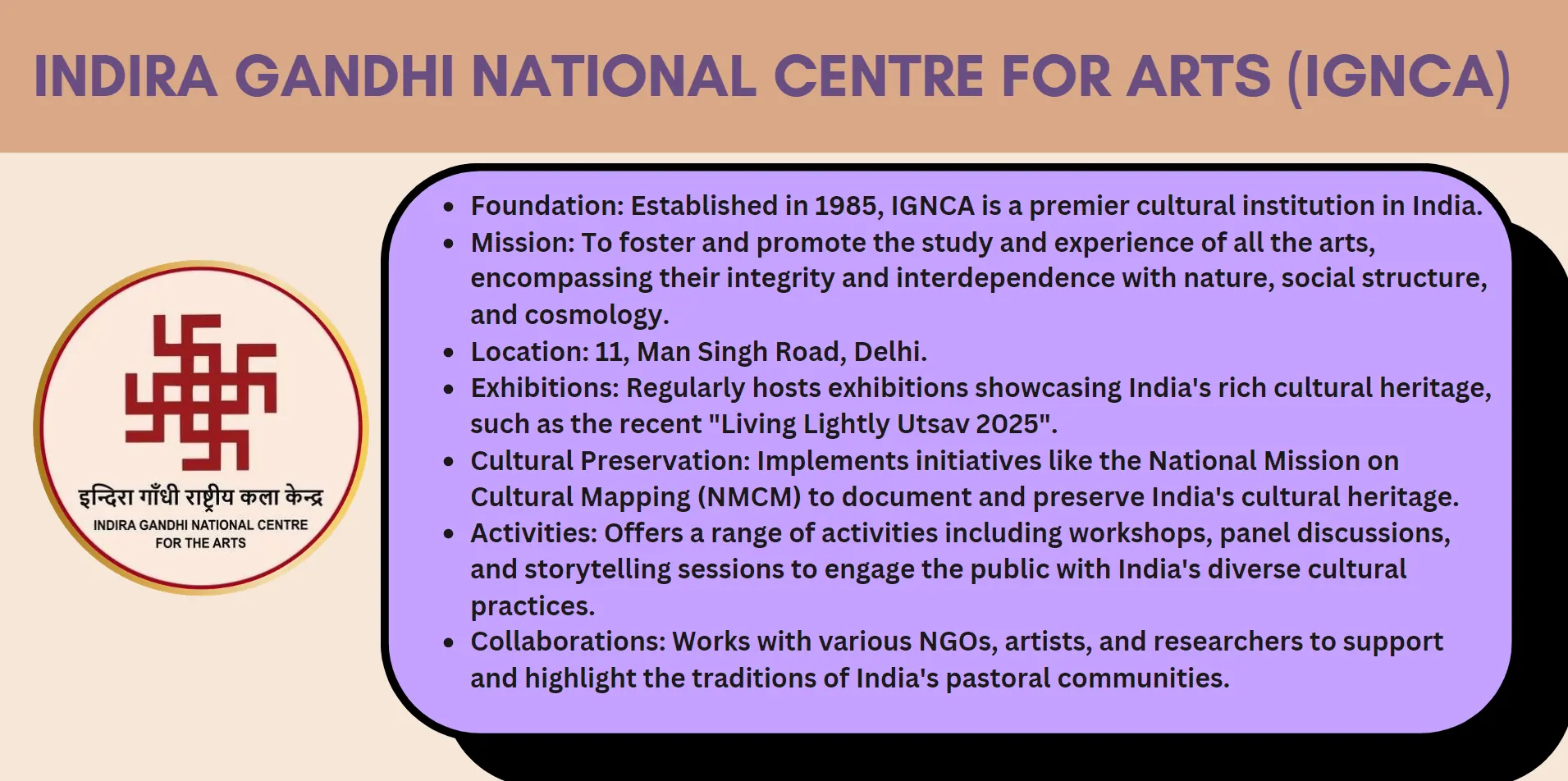
Organized from February 1st to February 16th in Bangalore, the Living Lightly Utsav 2025 is a colourful event to support India’s pastoral communities. The sixth edition of the travelling pastoral show that took place in Indira Gandhi National Centre for Arts (IGNCA) Regional Centre, Nagarbhavi depicted the traditions, ecological practices, and versatility of the pastoralists of the Deccan region.
The IGNCA stands as an appropriate cultural institution in India to host this occasion. Due to its extensive grounds with gardens and theatres and modern auditorium spaces the festival stage at IGNCA provides an appropriate setting that blends harmoniously with natural elements. The Living Lightly Utsav demonstrates its mission to educate people about sustainable life principles together with ecological footprint reduction practices.
The Utsav includes an essential part which features a program of education sessions where environmentalists conduct thought-provoking lectures and discussions with activists and scholars. The sessions in the Utsav explore diverse topics directed toward educating attendees about climate change and biodiversity preservation combined with renewable power generation and sustainable agricultural methods. Through their planned evaluation method the discussions encourage participants to join significant environmental dialogues about current issues while motivating individual audience members to start life changes.
The Utsav includes educational workshops that guide participants through practical sustainability practices which complement its intellectual learning sessions. Attendees have opportunities to study organic agriculture and witness composting techniques while learning waste disposal methods and green art creations. Expert leaders conduct sessions which share important life-applicable knowledge. Existing sessions encourage participants to synchronize their learning and sharing experiences through active connections with each other and the material discussed.
During the Living Lightly Utsav various energetic cultural performances entertain all attendees. Traditional music along with dance formats from different parts of India creates a showcase of the national cultural heritage during the event. The cultural shows at the Utsav entertain the audience while reminding people about the essential link between cultural traditions and natural surroundings. Actors at this event are commonly indigenous people who maintain traditional lifestyles that champion ecological protection and environmental care.
As a part of the Utsav organizers display a variety of environmentally friendly products and innovations through their exhibition area. The exhibition provides visitors a preview of earth-friendly approaches to sustainable life through exhibits of solar-powered technology and biodegradable materials. Home-grown local entrepreneurs can present their products and business stories while this platform acts as a gateway for sustainable practice promotion.
The Living Lightly Utsav provides visitors with an unforgettable experience that enables them to immerse themselves in its activities. The event provides ample ways for people to interact with both the material and fellow participants during its dynamic framework. The Utsav enables visitors to participate in nature-guided tours and collaborative artwork projects which foster environmental accountability for the collective community.
The effects of the Living Lightly Utsav continue after the event concludes. People who participate in the event gain both an enhanced comprehension of sustainable practices and useful skills to incorporate into their daily routines. People who join the Utsav find inspiration to embrace environmental friendly lifestyles and to become active supporters of environmental defence.
Key Highlights
- Among the most notable parts of Utsav, there was this called Alemari Bazaar which one could refer to as a fair of crafts, designs, and materials associated with shepherds. It was an exciting affair which brought in several master craftsmen from different cultural backgrounds, where the viewers can get to watch them at work and the environmentally sustainable products were on sale.
- The Utsav also supplemented by Pastoral Cafe, which entailed a gauntlet for the culinary theme inspired by pastures. Intending visitors could enjoy food prepared from locally sourced foods; this gives a flavour of the pastoral nature.
- Several interesting presentations and forums were conducted concerning future and current issue of the pastoralists, for instance; availability of forages, marketing opportunities, and prospects in the sphere of ecological conservation. These contributed to the creation of forums where these two groups could discuss and share ideas: the pastoralist; the settled agricultural producers; policy makers; and researchers to bring in a more elaborate understanding of the problem and possibly the solutions.
- The film festival proved another incident noteworthy in the event as several movies that portrayed different aspects of nomadic pastoralism were screened during the event. These films raised ideas and concerns on sustainability and resilience regarding pastoralism, and gave an understanding on the existence of such communities.
- Additional to this, getting a curatorial and artists’ led tour of the various exhibits helped visitors understand the significance of the artwork and the messages behind each of them. These walks enabled the participants to get fully capped, through emersion, with the different aspects of pastoralism and its harmonious relation with the rest of the natural endowment.
- The Utsav also featured various performance arts showcasing the ways of the past rural life in other parts of the city. The rich cultural heritage of pastoral communities was brought to the fore through music, poetry and theatre performances at several venues in Bangalore.
- Also in the venue there were different art forms like crafting techniques, folk songs and cheese making process that one can learn from. These sessions were the valuable session for one to enhance knowledge, skills and learn the sustainable way of living with the nature.
- The valuable work of the researchers and academicians has brightened the knowledge of the pastoral culture to the general public. People came to know more about these communities and learn from them and make their lives better.

Lessons from pastoral Living
These communities illustrate essential sustainable practices through their lives during the pastoral period. The pastoral way of life depends upon time-tested practices which develop from environmental conditions and the necessary survival of human ecosystems and natural ecosystems. Analyzing sustainable practices in pastoral communities reveals important concepts which can help create sustainable living systems in present times.
Manage natural resources
Pastoralism displays an effective strategy to manage natural resources among its many characteristics. Shepherds navigate between various pastures seasonally because these movements serve as a preventive measure against excessive animal grazing and damage to land stability. The rotational grazing approach permits land recovery and allows for regeneration which preserves soil fertility together with biodiversity. Modern agricultural practices usually practice monoculture systems that strip nutrients from soil and force farmers to increase their exclusive use of chemical pesticides and fertilizers. By implementing rotational grazing techniques with poly-culture farming methods farmers can restore soil health and achieve lower environmental impacts in their operations.
Water resources
The proper management of water resources constitutes a vital component of pastoral life practices. Pastoralists demonstrate exceptional ability to identify water sources and maintain water levels in dry and sub-tropical areas. Their traditional knowledge directs them to discover water sources while enabling them to manage water usage and maintain sustainability. The habit of overconsumption and wasting water in urban and industrialized regions fail to value their water resources. The adoption of sustainable water practices includes implementing rainwater harvesting combined with efficient irrigation systems and grey-water recycling methods can help recharge our water resources. These practices foster water preservation with decreased strain on natural water sources.
Knowledge of Surrounding Ecosystem
The pastoralists show exceptional knowledge about their surrounding ecosystems together with wildlife populations. The pastoralists understand the critical role of biodiversity in sustaining ecological equilibrium therefore their practices focus on living alongside wildlife. Modern development practices often show a damaging behaviour when human advancements lead to the destruction of wildlife habitats. When we implement land management based on the whole system we build wildlife corridors that help protect natural habitats which promotes biodiversity conservation.
Community-oriented living
The principle of community-oriented living defines pastoral societies as a defining aspect. Members of pastoral communities unite in small groups for resource sharing while making joint decisions together. This sense of community fosters cooperation, resilience, and a reduced ecological footprint. Residents in present-day cities achieve better sustainability results when they promote neighbourhood involvement along with friendly living standards. Community gardens alongside shared transportation networks with local exchange systems function as tools to minimize environmental resource use while promoting group-wide environmental responsibility.
Waste Management
Pastoral communities practice efficient waste recycling through their limited waste generation patterns. Communities compost their organic waste materials to create compost or provide it as animal nourishment and fix non-organic waste items before reusing them. The quantity of waste produced under modern consumer culture exceeds past levels and leads waste to accumulate in landfills. We should adopt sustainable waste management through the initiatives of material reduction as well as reusing and recycling elements. Waste levels along with their environmental impact can decrease substantially through the adoption of composting programs and reusable product usage and circular economy framework promotion.
Sustainable source
Pastoralists persistently use renewable resources in their sustainable way of life. Pastoralists depend on local resources for housing construction along with their everyday necessities that decreases their environmental impact. Modern societies should embrace sustainable renewable energy technologies including solar power along with wind power and biomass energy to decrease dependence on fossil fuels and lower their carbon footprint. The implementation of sustainable building methods with local eco-friendly construction materials allows for both more power-efficient and environmentally sustainable architecture.